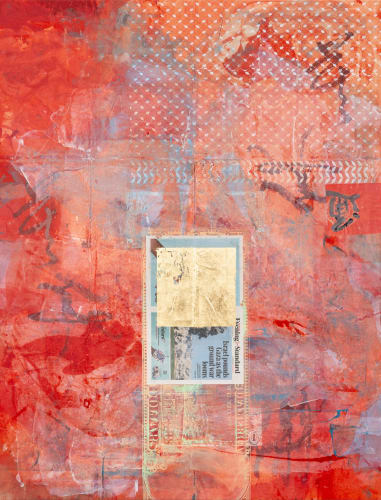Curated by Sara Raza, London-based artist Mandy El-Sayegh presents, A rose is a rose is a rose is a rose, her inaugural solo exhibition at Lawrie Shabibi. A combination of painting, installation, video, sound, and performance, El-Sayegh's innovative approach to visual storytelling embodies the rebellious spirit of punk's DIY visual culture. El-Sayegh rebels against and liberates images and text from centralised commodification structures, exploring a fusion of various actions, creating an immersive audio-visual experience that weaves together ancestral, familial, and collective visual data from diverse sources such as ephemera, textiles, literature, newspapers, and printed materials.
El-Sayegh transforms the gallery space by layering painted surfaces using sheets from international newspapers of varying colours. Stretched canvases and unfinished paintings, rich with intricate patterns, symbolic references, and collages, further populate the white walls. The exhibition borrows from ancient and modern poetry and the title of the show is borrowed from a line in Gertrude Stein’s Sacred Emily (1913), which reflects on the practices of daily life, through the repetition of words and the reclamation of language, actions, events, and objects.
As part of the project, sound artist Sami El-Enany has been commissioned to craft a spatialised, multi-channel sound work in response to the themes explored in El-Sayegh’s art. This work, نافورة (Nafoura), meaning ‘fountain,’ references fountains dyed red during liberation movements, and seeks to situate the listener within a flowing, ever-changing sonic geometry. El-Enany has also composed a new score for a performance piece co-created by El-Sayegh and movement artist Chelsea Gordon. The performance draws from diverse prayer rituals, incorporating hypnotic rhythms and motions to evoke trance-like states.
A rose is a rose is a rose is a rose showcases Mandy El-Sayegh's unique bricolage approach, connecting disparate visual cultural knowledge to create new meanings. The exhibition is an exploration of resistance, reclamation, and the intersection of visual and auditory narratives. To complement the exhibition, curator Sara Raza has contributed an insightful essay that provides a deeper understanding of the artist's work and the thematic threads running through the exhibition.

